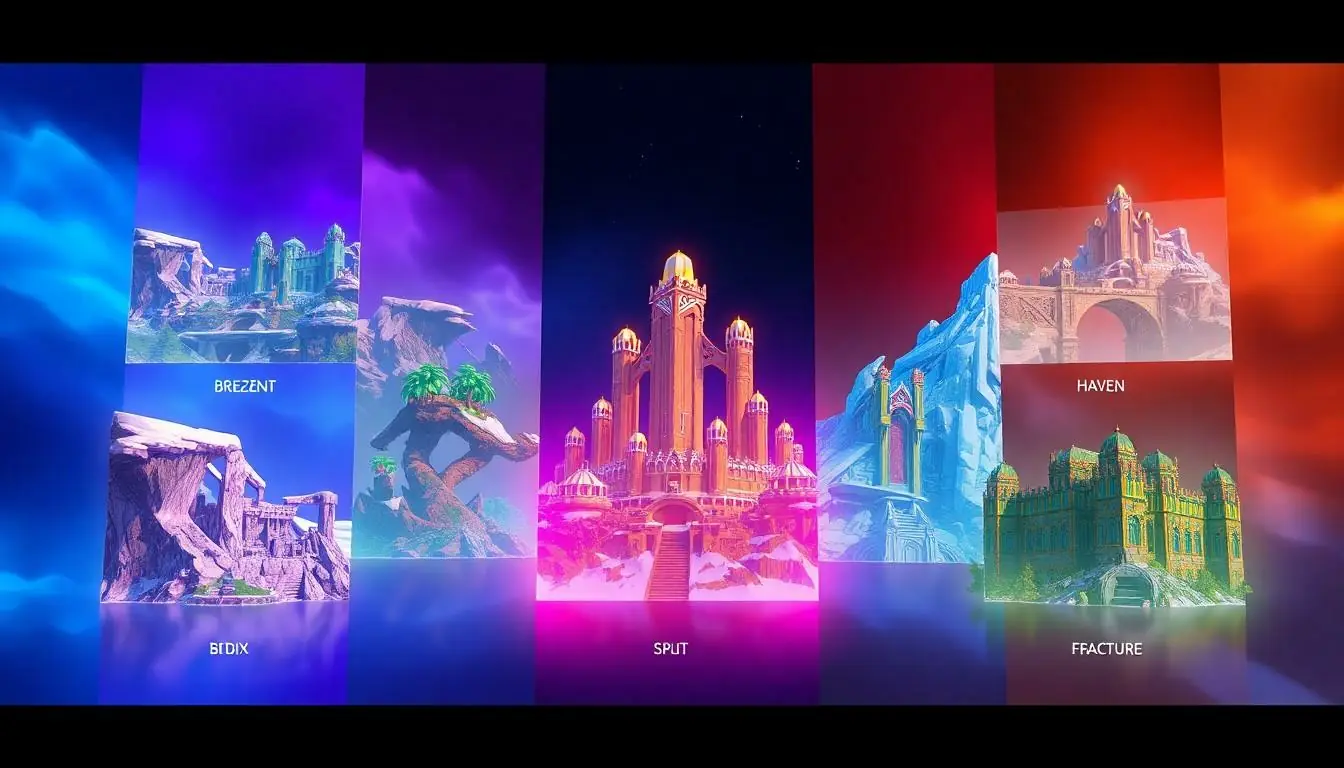Table of Contents
ToggleIn the fast-paced world of Valorant, the map pool is like a buffet—there’s something for everyone, but some dishes are definitely more popular than others. Whether players are sneaking through the shadows of Ascent or launching themselves into the chaos of Bind, each map offers unique challenges and opportunities. Understanding the intricacies of the map pool can mean the difference between a glorious victory and a facepalm-worthy defeat.
Overview Of Map Pool Valorant
Valorant features a map pool that consists of seven distinct maps: Ascent, Breeze, Haven, Icebox, Split, Bind, and Fracture. Each map brings its own set of layouts and strategies, which players must learn. Understanding the unique characteristics of these maps plays a critical role in gaining a competitive advantage during matches.
Ascent offers an open middle area that encourages aggressive plays. Players should utilize the numerous sightlines to control mid and secure key advantages. Breeze emphasizes long-range engagements with sprawling, wide-open spaces, making sniper rifles particularly valuable.
Haven stands out due to its three bomb sites, providing a unique dynamic. Teams often adopt different strategies to exploit this advantage, so mastering rotation is essential. Icebox presents verticality in gameplay with its elevated platforms and zip lines, fostering innovative tactics that players can leverage.
Split, known for its tight corridors, rewards teams that excel in close-quarters combat. Emphasis on utility usage significantly impacts gameplay here. Bind introduces teleporters that allow quick mobility between sites, creating fast-paced encounters. Focusing on timing and communication enables teams to execute strategies effectively.
Lastly, Fracture features a semi-unique layout with two starting sites and a central area. This design encourages creative strategies, forceful execution, and frequent engagements throughout the match. Observing these differences across maps provides insights into effective game plans, boosting performance in competitive play.
Current Map Pool
The current map pool in Valorant includes seven maps, each presenting unique gameplay dynamics. Players must adapt their strategies based on these distinct layouts.
Overview of Each Map
Ascent presents an open central area that supports aggressive tactics. Breeze focuses on expansive distances, making long-range weaponry more effective. Haven distinguishes itself with three bomb sites, demanding precise team rotations. Icebox features vertical elements, offering players opportunities for innovative tactical plays. Split emphasizes close-quarters engagements, rewarding clever use of utilities. Bind utilizes teleporters, creating fast-paced action that hinges on timing. Lastly, Fracture’s semi-unique structure fosters innovative strategies and frequent confrontations.
Unique Features and Strategies
Each map’s design promotes distinctive strategies. Ascent encourages control of the middle to dictate flow. Bold snipers thrive on Breeze’s long lanes, taking advantage of distance. Haven requires coordination for successful site navigation and bomb planting. Icebox’s verticality calls for players to leverage high ground for sight advantage. Split’s tight corridors favor strategic utility placement to outmaneuver opponents. Bind’s teleporters necessitate teamwork and communication to catch foes off guard. Fracture’s layout challenges players to devise creative tactics that reflect the map’s complexity.
Map Rotation and Updates
Map rotation and updates significantly shape the competitive landscape in Valorant. Each change provides new strategies and challenges for players navigating the current map pool.
Importance of Rotations
Rotations play a crucial role in both offensive and defensive strategies. Mastering quick rotations enhances a team’s ability to respond to opposing movements effectively. Teams can shift their resources, adapt to site takes, and control the pace of the game. Quick on-site rotations provide opportunities to prevent bomb plants and set up defensive positions. Additionally, maintaining a keen awareness of the enemy’s positioning allows teams to anticipate their next moves. Successful rotations enable better communication and coordination, reinforcing a team’s overall strategy.
Recent Changes to the Map Pool
Recent changes to the map pool can drastically impact gameplay dynamics. Updates have included adjustments to map layouts, altering angles and pathways. Icebox recently received changes to its verticality, forcing players to adapt their strategies around new lines of sight. Breeze saw slight adjustments in site design, promoting more strategic plays for attackers. The introduction of new tactical elements encourages players to rethink their approaches. Keeping up with these updates ensures teams remain competitive and effective in executing their strategies. Regularly analyzing patch notes serves as a key practice for adapting to the evolving map environment.
Competitive Scene and Map Pool Valorant
The competitive landscape in Valorant relies heavily on the map pool. Knowledge of each map’s intricacies informs strategic gameplay decisions for teams.
Impact on Professional Play
Understanding the map pool significantly influences professional play. Teams often develop specialized strategies for each map, tailoring their approach to fit unique layouts. Utilizing strengths of maps like Haven and Icebox can create significant advantages during tournaments. Successful teams frequently adapt their gameplay based on map rotations, ensuring they are always one step ahead of opponents. Given that recent changes to the map pool can shift competitive dynamics, teams must regularly assess their strategies to maintain peak performance. Staying updated on these changes plays a vital role in shaping how teams prepare for upcoming matches.
Popular Strategies in Competitive Matches
Popular strategies in competitive matches reflect the unique attributes of each map. Players often focus on controlling critical areas such as mid on Ascent or the high ground on Icebox. Effective use of utility is paramount, especially in tight corridors on Split, where smoke and flashes can alter engagements. Teams leveraging Bind’s teleporters can disrupt enemy rotations, creating opportunities for surprise attacks. Additionally, coordination is crucial on Haven, as teams frequently adjust their tactics based on bomb site pressure. Adapting strategies in response to map-specific challenges often determines the outcome of tense encounters in tournaments.
Future of Map Pool Valorant
The future of the Valorant map pool looks promising, with continuous updates anticipated to enhance gameplay dynamics. Developers regularly reassess map features, ensuring that each environment remains engaging and competitive. Players can expect new maps to introduce fresh mechanics, keeping strategies dynamic across various matches.
Upcoming changes may include alterations similar to those seen on Icebox and Breeze, which recently underwent improvements. Adjustments like these can dramatically influence how players approach tactics, requiring teams to adapt quickly. Continuous integration of community feedback will help maintain a map pool that reflects player experiences and expectations.
Recent trends indicate an increased focus on verticality and diverse layouts, bringing new depth to gameplay. With elements such as high ground opportunities, players will likely encounter evolving strategic approaches, especially in competitive settings. As maps change, teams will need to emphasize coordination and communication even more, particularly on complex maps like Haven.
The balance of power among maps will also play a crucial role in the future landscape. Equalizing gameplay will ensure that no single map dominates the competitive scene, fostering varied strategies and techniques. By learning and mastering map-specific nuances, teams can gain essential advantages in tournaments.
Understanding shifts in the meta will be essential for players to remain competitive. Regularly examining patch notes will enable teams to grasp any changes that affect strategies and player roles. With the potential for new maps and modifications, players must stay adaptable, ensuring that familiarity with each map’s intricacies translates into superior performance.
Conclusion
The map pool in Valorant plays a pivotal role in shaping the competitive landscape. Each map offers distinct challenges that require players to adapt their strategies for success. Mastery over the intricacies of maps like Haven and Icebox can provide teams with a significant edge during matches.
As the game evolves with updates and new maps, players must stay informed and agile. Understanding the nuances of each map will not only enhance individual performance but also strengthen team coordination. With continuous changes on the horizon, the future of Valorant’s map pool promises to keep players engaged and competitive.






